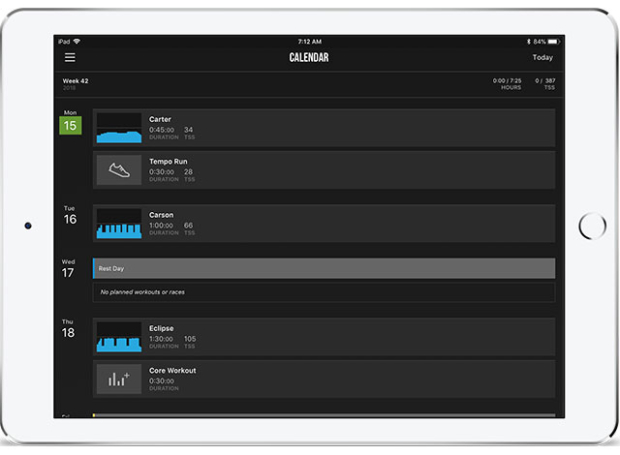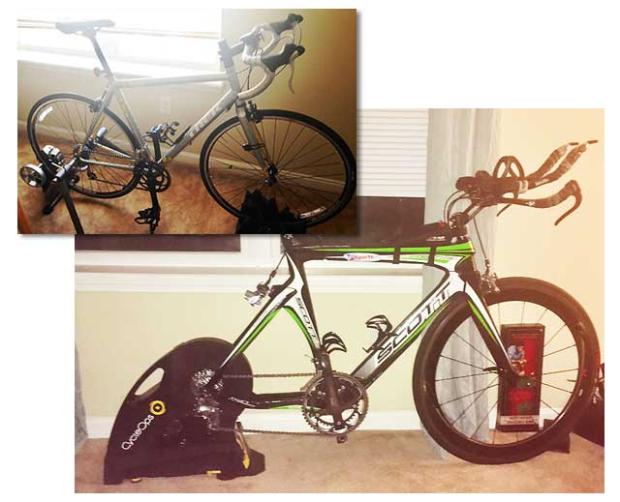Trainerroad: The Birth of Structured Training
It's the end of a year, a good time to reflect. This site's publisher just wrote about the Chuck Wurster, whose legacy endures as a man, and as an innovator. It was memorialized in the following thesis: If you like today's stationary tech, you must thank Chuck Wurster and Computrainer for a great deal of it.
Computrainer was both a hardware and software platform. Yes, you could build workouts in its companion software Racermate so, arguably, that system was both the first smart trainer and the first structured training option. But if we're to honor Computrainer for the impact it made on today's stationary landscape, Trainerroad deserves the mantle as the birthplace of structured training as we now know it.
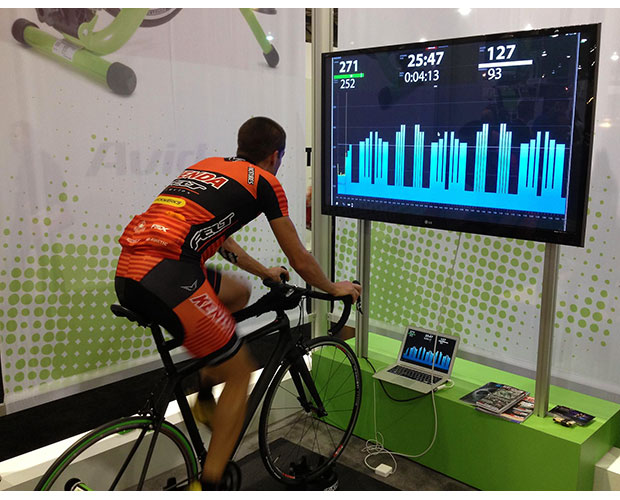
The image above is of Trainerroad at Interbike, in 2012, the year after its intro (aboard is Drew Edsall). The image below is of a makeshift sound booth then used to record Trainerroad instructional videos.
Simply put, if Zwift's workout builder—and the "Zwift Industry" analogs, like zwofactory.com—are a market reaction, it's to Trainerroad, not to Computrainer or anything else. As of 2016 Slowtwitchers close to half (44 percent) chose Trainerroad as their favorite stationary platform, and the other 11 named platforms (Zwift, Sufferfest, FulGaz, Golden Cheetah, PerfPro and the rest) split up the remainder.
I think when we look back to 2011, and what we had available to us for indoor training tools at the time, TrainerRoad was a disruptive technology. As of 2011 we had the following:
– Computrainer, with RacerMate software: expensive, proprietary, tedious to set up, and kind of "hardware first" – the software supported the hardware rather than the hardware supporting the software. At the time, the Computrainer was relatively high on training quality and somewhat high on entertainment, especially when used in a group environment.
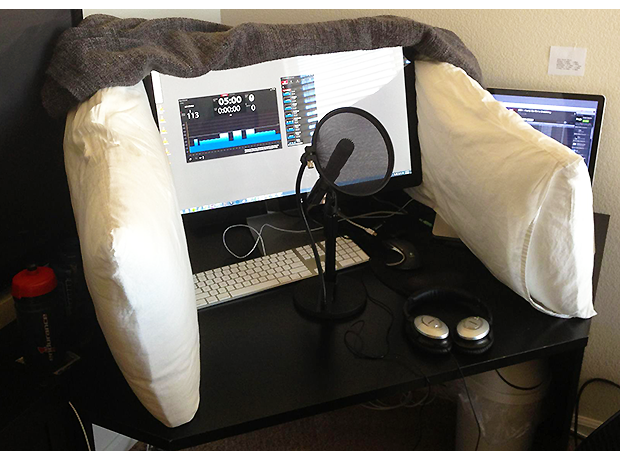
– Maybe Tacx with their trainers with then-proprietary software: At that time, I didn't have much visibility to Tacx, as they were mostly a European entity and not available at my local shops. So, my perception was that they were out of my reach and I probably didn't give them the credit they deserved as being decent competition to Computrainer/Racermate. Tacx was probably right there in training quality and entertainment but, honestly, they were then and, to U.S. audience, still this amorphous European entity.
– Lots of dumb trainer options: At this point, we were still contemplating if a fluid trainer was really that much better than a magnetic trainer. Training quality depended as much on the owner as the tool itself—you had to want to get in a quality workout and had to educate yourself on how to do that. Entertainment was relatively low.
– Entertainment products: We had DVDs like Spinervals, RealRides, Sufferfest (still in their infancy), to at least provide a bit of entertainment, and a little bit of structure based on Rate of Perceived Exertion. Combined with a dumb trainer, they could provide a medium quality workout, somewhat specific to the athlete, with a bit more entertainment value.
– Other factors, such as spin bikes/classes, coaches, power meters, treadmills, and ANT+: These weren't at the heart of indoor training in 2011, but were there as either alternatives or influencers. I would even throw Slowtwitch and other cycling/triathlon forums in there as influencers.
All of these things by themselves were nice, but disjointed at the time. The net result was that the pain cave was somewhat torturous and on a scale of 1-10 most people probably got a workout quality of 1 or 2, with the more knowledgeable and resourceful folks getting better than that based on their knowledge, having a good coach, or spending the money on the CT or Tacx solutions.
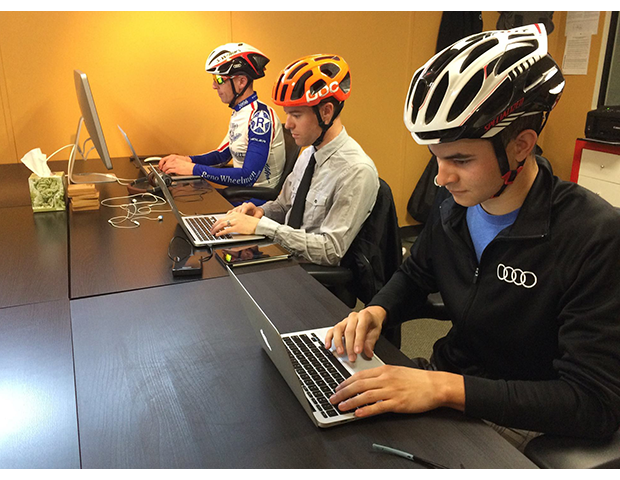
Trainerroad (TR) disrupted the market by bringing all of these disjointed elements together. (The image above was a whimsical moment showing TR's support stuff at work with your queries.) The glue was the Virtual Power construct. It wasn't their idea (I'm not sure who really invented it, but I found articles dating back to the early 2000's on the concept), but what they did is bring training with power to the masses. They combined some software geekery, the piles of relatively affordable trainers, ANT+, a coach willing to design workouts for them, a bit of workout organization in the form of training plans, and a few basic sensors together into a clean, easy-to-read interface with data that could be shared with a coach and turned the indoor training world on its head.
I was part of their beta, and actually learned about it from a Slowtwitch thread. I had the pieces and parts—a basic CycleOps magnetic trainer, Garmin speed sensor, cadence sensor, and heart rate monitor, an ANT+ 1.0 dongle and a computer—and now my world was opened to real structured training, using virtual power, which, while not perfect, is still a decent number that can be trained to, versus RPE or heart rate.
Virtual Power took that training experience from a 1 or 2 up to about 6 or 7 to anybody who could put those few parts together. The training was not only better, but now more people could do it. The bar was raised pretty high with the introduction of TR.
TR built a solid meat-and-potatoes meal on the following elements:
1. Virtual Power
2. Open communications protocol
3. Wide open hardware compatibility (both trainers and electronic devices: PCs, Macs, iPads, iPhones, Android)
4. A good selection of structured workouts included with the package
5. A good selection of training plans tailored to specific disciplines
6. Decent metric/analytic output
7. Ease of use
8. Affordability
As of now, numbers 1 thru 3 above can be leveraged by anybody now, 7 and 8 are relative to the individual user, but 4 thru 6 are the heart of quality structured training; not only each second of each workout, but how each workout fits into the week, month and season. The folks at TR were smart to do that all off the shelf, as part of the package. There is a lot of value in their workouts and training plans. It's like 1,000 different Spinervals videos for $15 a month, plus whatever people might spend to have a coach write up a generic plan, but better.
TR also got ahead of the curve with their workout creator.
TR also introduced the support for video workouts, which meant having a coach translate those RPE Sufferfest or Spinerval videos into power-based workouts. I remember the first time I did the Sufferfest's Fight Club video with TR. My concept of riding a 10 out of 10 during that 16th hidden interval was really about a 6. Once I learned to trust the series of blue boxes and the yellow squiggly line on screen, I was training a lot more intelligently without having to think about it. And I was entertained. (Below is a vintage pic of TR's basement photo studio.)
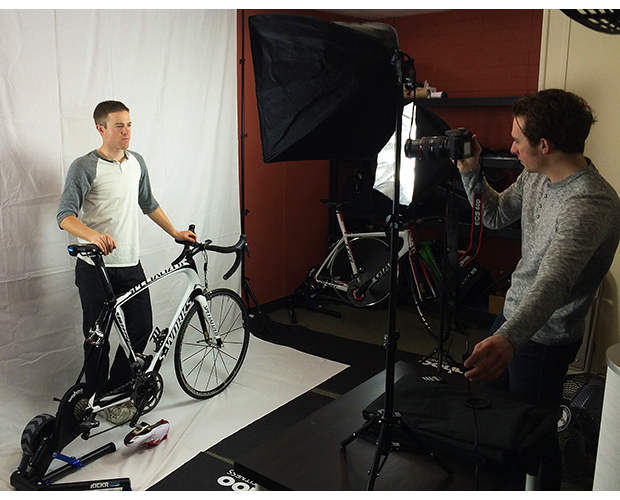
With that said, TR started a few trends that brought everything closer: building on the open ANT+ and subsequent ANT-FE-C and Bluetooth tech means they could focus on software rather than hardware, and others could follow suit. I think we're seeing that realized now by the hardware manufacturers, as they learn to be a part of the overall indoor training landscape. Computrainer missed the break on that. Wahoo, Tacx, Kinetic, Elite, and CycleOps leverage ANT-FE-C and Bluetooth to make hardware that can talk to any software, while spinning off their software products so they can work with any hardware. The software options continue to expand and get better, the hardware options continue to get better, and the technologies and standards make for a more plug-and-play world.
We're now at a point where we're experiencing the results of a distillation process that was sparked by TR. They inspired others to look at their concept (PeriPedal, PerfPRO haven't been mentioned yet) and try to expand on it. The software competition is fierce, with each product putting their spin on what TR did while trying to create their own identity. The hardware has also become kind of a parallel arms race. Late 2016 gave us the Hammer, Magnus, Kinetic Smart Control, Tacx Flux, and others, along with what was already out. Late 2018 has now brought us nice refinements on all of these in the H2, M2, newest generation Wahoo products, Kinetic Control units, Kinetic R1, and updated Neo and Flux, not to mention what Elite has going on. The competition is beneficial for us, as consumers.
You can probably take any element on my list above about what TR does right and find someone who does any one of those better, but TR did them all sooner, established a standard, while doing it for a low price, and TrainerRoad is a solid, easy-to-use product. It is still is hard to beat.
The challenge is how to enhance the product without negatively impacting their strengths. They do a really good steak and potato, so do they stick with what they do well or start introducing other stuff to the menu? Zwift is more entertaining than TR, but it wasn't as effective as a training tool until they added structured workouts. TR's workout selection is still top-notch, with well over 1,000 workouts. I am not aware of anybody who has done a better job with the training plans, but Zwift is probably the one that is gaining most rapidly. Rouvy is a lot of fun and offers a different entertainment appeal than Zwift, but really hasn't a library of training plans yet.
Is TR as relevant today as it was in 2011? Here's a story of 2 pain caves. I spent part of last Sunday setting up a CycleOps H2 with Zwift, Apple TV 4K, and a 75" U4K TV at a customer's ultimate pain cave. He and I had discussed this a few weeks ago, he did some further research, and settled on Zwift because he felt it met his needs. His main objective was to have fun and get structured workouts.
The day before, Saturday, was a very different story. New customer looking to buy a triathlon bike. She had a budget of $1,200, including pedals, hydration, and other accessories. She admitted she knew nothing about cycling or training, although she has a Kinetic Road Machine trainer and a free coach that gives her workouts based on HR zones. She rides about once a week because she would rather do other stuff. We looked at and discussed Rouvy, Zwift, PerfPRO Studio, Sufferfest, and TrainerRoad. I showed her my low-budget pain cave. I showed her how I like to ride Rouvy because it entertains me, but I'm also not training for anything in particular. We talked about FTP, IF, TSS, periodization, and the TR 8-week training plans. She decided she liked Trainerroad because of the training plans and the simplicity. She liked the idea of seeing the yellow squiggly line and blue boxes. That made sense to her. I shared the recent Slowtwitch article on the TR Calendar, as well as the Rouvy and Zwift articles. She was certain TR is exactly what she needs. Those training plans are the best guide available, short of a coach. Trainerroad checks all the boxes for her, Zwift seemed a bit overwhelming for her, Rouvy doesn't provide sufficient guidance for her, PerfPRO Studio is too hard. For her, it kept coming back to the TR training plans.


